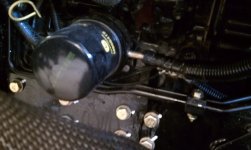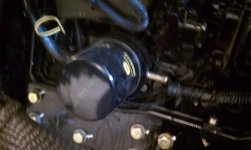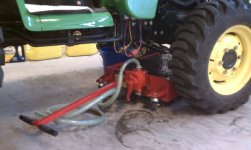Riderguy
Bronze Member
Below are some pictures I took of my first coolant change on my 2009 3720. The procedure is on pages 62-63 of the manual. I elected to not do the flush, as a co-worker of mine who works on Deeres as a side job said it is not as necessary as just plain getting rid of the old fluid. He explained that the anti-corrosive package that is included in the coolant breaks down after about 3 years and it will literally conduct electricity after a certain period of time. That corrosive fluid will also rust out the inside of the radiator, thus changing the fluid is the best way to prevent costly repairs. After that explanation, it made sense to me and I thought I better do it, since the tractor is almost 3 years old.
Even with a large collection bin for the fluid, it is a messy procedure. The petcock that is on the left side of the motor is turned and the fluid comes out slowly at first. After a few seconds it comes out very fast and hard, hitting the front axle and spraying all over the place after that. Once that is drained, then the coolant recovery hose that is connected near the oil filter is removed and drained. This required 2 screwdrivers to break the seal and slowly move the hose back off the nipple. The fluid came pouring out of the nipple and a bit out of the hose, this time hitting the right side front axle and again splashing all over the place, most going in my fluid bin. Once this was drained dry I removed the coolant recovery tank and cleaned it out with fresh water. I replaced it, put the tube back on near the oil filter and put the petcock valve back in on the left side of the motor.
The new coolant was then poured in the radiator, the engine started and run for awhile to heat it up to operating temperature. During the heat up I hosed off the lower section to clean off the old coolant. I shutdown the tractor and a few hours later added some fluid to the recovery tank to bring it up to the full cold level. Overall, it is not difficult to do, just really messy. Have a big container and maybe put down a lot of old cardboard under the tractor, thus saving you the hassle of hosing down the garage floor after the procedure. Next time I do this in about 3 years, I値l probably do the flush first, just to make sure it is all really clean inside.






Even with a large collection bin for the fluid, it is a messy procedure. The petcock that is on the left side of the motor is turned and the fluid comes out slowly at first. After a few seconds it comes out very fast and hard, hitting the front axle and spraying all over the place after that. Once that is drained, then the coolant recovery hose that is connected near the oil filter is removed and drained. This required 2 screwdrivers to break the seal and slowly move the hose back off the nipple. The fluid came pouring out of the nipple and a bit out of the hose, this time hitting the right side front axle and again splashing all over the place, most going in my fluid bin. Once this was drained dry I removed the coolant recovery tank and cleaned it out with fresh water. I replaced it, put the tube back on near the oil filter and put the petcock valve back in on the left side of the motor.
The new coolant was then poured in the radiator, the engine started and run for awhile to heat it up to operating temperature. During the heat up I hosed off the lower section to clean off the old coolant. I shutdown the tractor and a few hours later added some fluid to the recovery tank to bring it up to the full cold level. Overall, it is not difficult to do, just really messy. Have a big container and maybe put down a lot of old cardboard under the tractor, thus saving you the hassle of hosing down the garage floor after the procedure. Next time I do this in about 3 years, I値l probably do the flush first, just to make sure it is all really clean inside.






Last edited:
